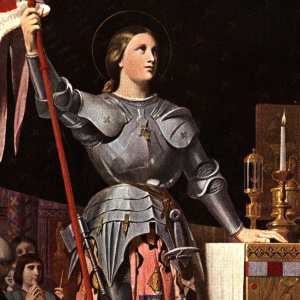
St Joan of Arc was a 15th century French peasant girl who was given visions by God to drive the English out of French lands and bring the Dauphin to Reims for his crowning. She is the patroness of France, soldiers, and captives.
Read the full St Joan of Arc novena on the novena page. You can also learn more about novenas here.
What is St Joan of Arc the patron saint of?
St Joan of Arc was a 15th century French peasant girl who was given visions by God to drive the English out of French lands and bring the Dauphin to Reims for his crowning.
She is the patron saint of France, martyrs, captives, military personnel, people ridiculed for their piety, prisoners, soldiers, women who have served in the WAVES (Women Accepted for Volunteer Emergency Service), and Women’s Army Corps.
Joan was born January 6th, 1412, in Domremy, France.
As a young girl, she heard the voices of Sts. Michael, Catherine, and Margaret.
These messages continued for many years, and at age 13, God gave her a vision of these saints, telling her to liberate France from English forces and get the Dauphin to go to Reims and be crowned.
At age 16, she repeatedly asked Robert de Baudricourt, the garrison commander, for approval to visit the French Royal Court in Chinon.
Joan prophesied to Baudricourt that the French would suffer a bad defeat at the Battle of Rouvray, and days later he received confirmation that indeed her prophesy was accurate, leading him to believe that God was speaking to Joan.
Baudricourt provided an escort to Joan to the Court at Chinon, which passed through Burgundy, then a dangerous area for French to travel through.
At Court, Joan spoke with Charles VII, who gave her approval to travel with the army and wear armor.
Joan made it to Orléans, and she predicted that they would successfully lift the siege there. She gave wise advice to the French commanders for the battles, which turned the tide in their favor.
In one battle, Joan was wounded by an arrow, but she courageously returned and witnessed the lifting of the siege.
After Orléans, Joan convinced Charles VII to include her in subsequent battles, each seeking to recapture cities. The French won victory at each of these battles.
Joan was eventually captured by the Burgundians, who sold her to the English.
The English clergy put her on trial for heresy in an attempt to execute her.
The trial was unjustly rigged against Joan, yet by God’s grace she evaded their theological traps, one of which went this way: Joan was asked if she knew with certainty that she was in a state of sanctifying grace, and she answered: If I am not, may God put me there; and if I am, may God so keep me.
Despite a total lack of evidence, the tribunal found Joan guilty and condemned her death in 1431.
Joan was executed by burning on May 30, 1431, whereupon the English threw her ashes into the Seine River.
She was beatified on April 18th, 1909, by Pope Pius X, and canonized on May 16th, 1920 by Pope Benedict XV.